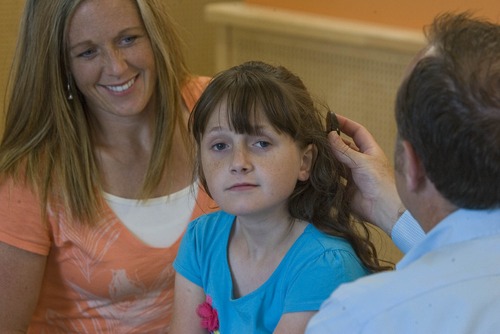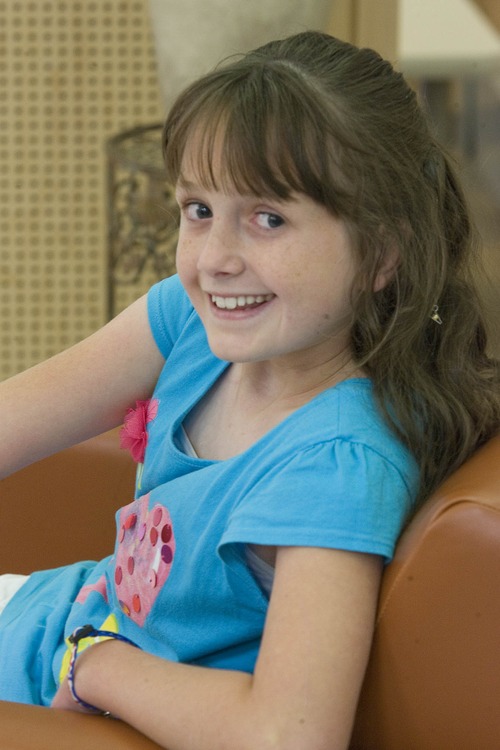This is an archived article that was published on sltrib.com in 2013, and information in the article may be outdated. It is provided only for personal research purposes and may not be reprinted.
Emily Heaps isn't happy with the upgrade to her cochlear implant.
"I hate it. My voice sounds different," she tells the doctor, who assures her that in time, perhaps over ice cream, she'll get used to the new sound processor.
Hearing loss and a stubborn streak are the only residual signs of Emily's battle with severe combined immunodeficiency syndrome (SCID), also known as "boy in the bubble" syndrome for the extreme quarantine steps once taken to protect these children from infections and almost certain death.
"We were lucky," said her mom, Jill Heaps. "Emily was diagnosed earlier than most kids."
Starting on July 1, however, every newborn in Utah will be screened for SCID, leaving less to chance and allowing doctors to catch the disease earlier — when treatment is more likely to work.
Utah was the 13th state to add the rare, genetic disease to its newborn "heel prick" test, alongside 37 other debilitating and lethal disorders, such as cystic fibrosis and sickle cell disease.
Two other states are doing partial SCID screening and another 14 have passed legislation to start testing, said Harper Randall, a pediatrician and medical director at the Utah Department of Health who oversees the state's newborn-screening program.
SCID is rare. Precisely how rare is unknown because infants frequently die of infection before they're diagnosed. But it's estimated to affect 40 to 100 children in the United States a year, according to the Immune Deficiency Foundation.
The test isn't perfect and can turn up false positives. And it bumps up the price of newborn screening by $7.20 to $102.
But false positives are easily ruled out with confirmatory testing, said Randall. And studies have shown testing not only saves lives, but also money, by preventing expensive hospital stays, she said.
Children with SCID can't produce white blood cells essential to fighting infection, leaving them with severely weakened immune systems.
They appear healthy at birth, benefiting from the protective antibodies transferred to them in utero by their mothers, said Karin Chen, a pediatric immunologist at Primary Children's Medical Center and University Hospital.
But within weeks or months, they show up at the hospital with recurrent viral infections, such as the common cold, or a bacterial infection, she said. "Some wind up on a ventilator for days, weeks or even months."
Often it's not until the second or third infection that parents and doctors start to suspect an immune deficiency.
For this reason, the average age for a SCID diagnosis is 6.6 months — at which point chances of a successful bone marrow transplant, the treatment of choice, are diminished, said Chen.
Studies have shown those diagnosed and treated before 3 months have a 90 percent chance of survival or greater, she said. "It's even better if the child is transplanted at one month."
But the survival rate for children treated after 3 months drops to 67 percent, Chen said, because their immune system is too weak to tolerate the transplant.
Through a network of parents, Jill Heaps knows of two Utah infants with SCID who died this past year, one of whom was diagnosed postmortem.
"It's heartbreaking," said Heaps, recounting her daughter's propitious path to diagnosis.
Emily, now 11, was days old when she got an ear infection. "We treated it with antibiotics, but it didn't get better," said Heaps, who was eventually referred to Primary Children's.
It took 2½ weeks for specialists to diagnose Emily, who was by then 7 weeks old. "Labs had shown she had no T or B cells, but they thought it was a mistake," Heaps said. "It's just so rare."
Had Emily been flagged at birth, doctors could have supplied the family with prophylactic antibiotics and antiviral medicines, the standard practice, according to Chen. Infants with SCID are also warned to avoid vaccination with live viruses, she said.
By the time Emily received bone marrow from her sister, at 8 weeks of age, she was so sick, doctors didn't know if she'd make it, Heaps said. "As a parent, you don't realize how sick your child is until you look at pictures later."
The transplant never fully worked, but gave Emily some protection. She had to get regular intravenous doses of gamma globulin, antibodies extracted from plasma donors.
And she spent her first two years in seclusion at home. "She was only allowed to go to the hospital or grandma's house," said Heaps, who cleaned and sterilized the house every other day.
The Lehi family's hands were perpetually raw from all the washing. "Emily's brother used to joke, 'We're cleaning the clean,' " said Heaps.
But her daughter's health eventually improved enough for her to attend preschool and kindergarten.
By age 6, though, she started to decline and needed another transplant.
The second bone marrow treatment, also from her sister, took. Emily is now considered cured.
She has hearing loss and some neurological damage, which affects her learning.
"But she's alive. It's all relative," said Heaps, who is thankful her children, who could be carriers, will benefit from early screening. "She's had to be a fighter all of her life. If she can channel that in the right direction, it can be a real positive for her."
Twitter: @kirstendstewart —
"Bubble boy" disease is a real rarity in Utah
O Roughly 53,000 babies are born in Utah each year. Newborn screening for severe combined immunodeficiency (SCID), or the "bubble boy" disease, will flag 11 for further testing. After confirmatory testing, one to two infants will be diagnosed with SCID. Another five to seven will be diagnosed with another immune deficiency disorder, and one to three will be healthy.
Sources: Utah Department of Health estimates, based on Wisconsin's SCID screening experiences









